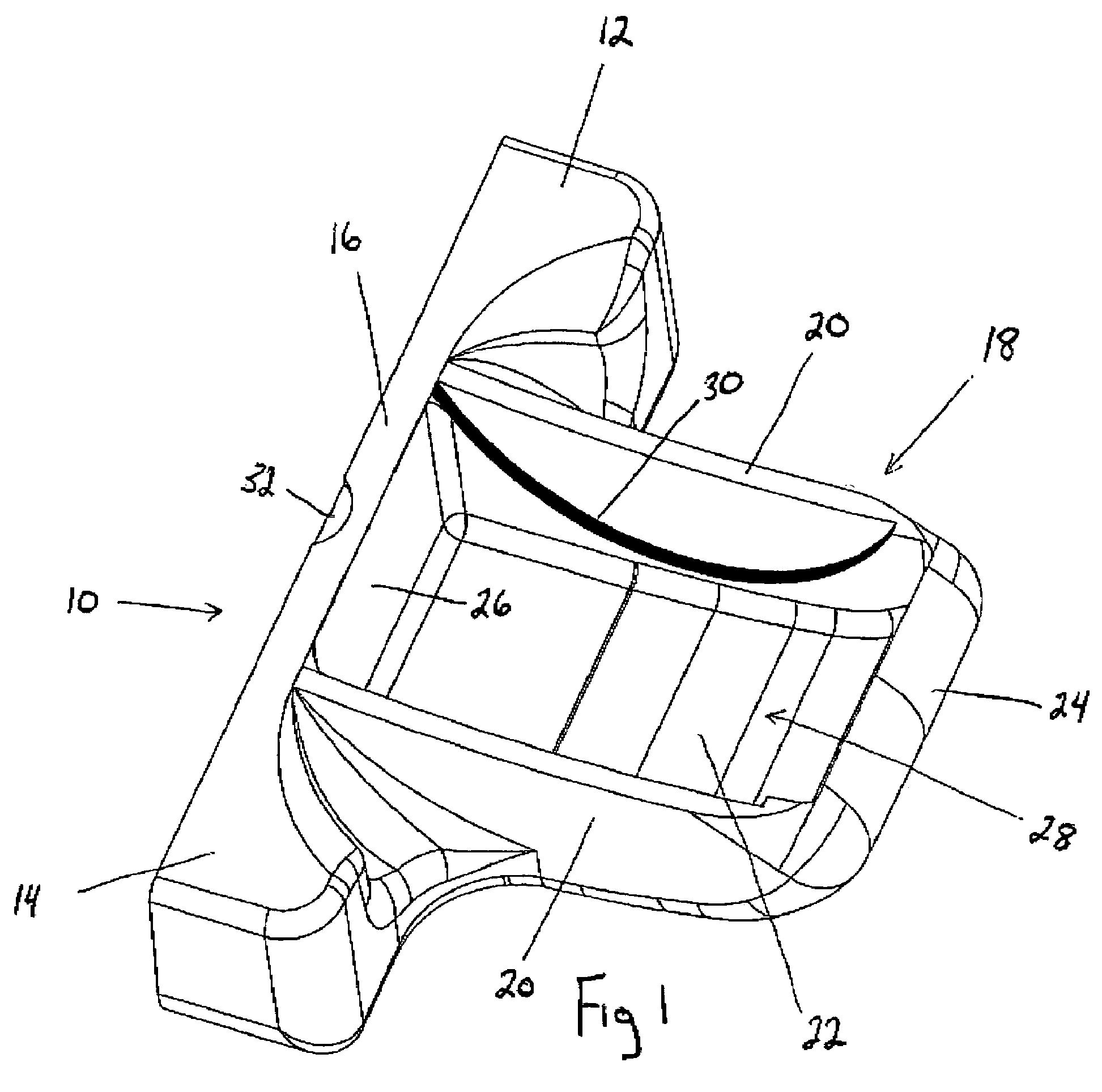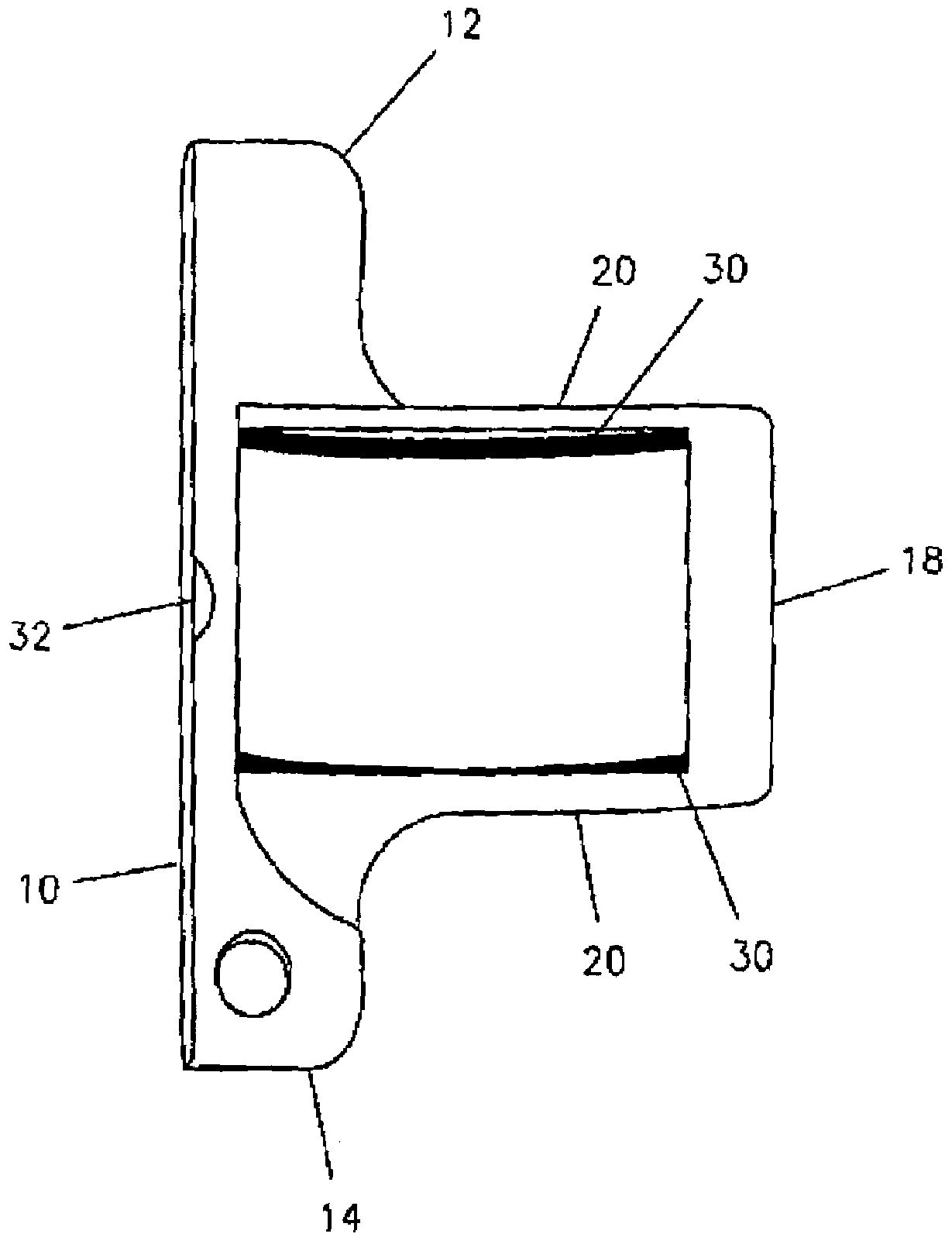Putter Alignment Features Are Getting More and More Creative
It seems like the latest hot trend in putter designs is unique alignment features, but not necessary features that help you align the putter with the ball and the hole. Rather, the trend seems to be directed to features that provide feedback to the user regarding their stance and stroke.
One putter with such alignment features recently issued as USPN 7393285 titled “Putter with Alignment Means.” The patent describes the invention as:
The present invention is a putter that provides reference markings for achieving a proper stance, as well as providing visual feedback through the user’s peripheral vision during the stroke itself. The reference markings of the putter aid the user in positioning his/her head directly over the ball, at the proper height, and aid in centering the ball on the striking surface of the putter. The markings further aid the player in keeping the centerline of the putter parallel with the aiming/putting line throughout the stroke.
The putter according to the invention comprises a putter head having a forward-facing striking surface, a heel, a toe, a top surface and a rearward-facing, elongated tail section. The elongated tail section has vertical side walls, into each of which is machined an elliptical, preferably semicircular, track or groove along the inside surface. The elliptical tracks are spaced from each other at a width slightly less than the diameter of a golf ball, and are machined into the sidewalls at a predetermined angle of incidence such that, when viewed from directly overhead, the tracks will be perceived by the user as two parallel lines, such lines being parallel with and equidistant from the center line of the putter. The top surfaces of the tracks are preferably painted in a contrasting color so as to emphasize the visual perception of the parallel lines.
The elliptical tracks provide an improved means of aiding the user in centering his/her head directly above the ball at setup. If the user’s eyes are not directly in line with the plane extending vertically from the centerline, then one of the tracks will increasingly disappear behind its respective sidewall, while the opposite track will appear to become increasingly curved, as the degree of misalignment increases.
The angle of incidence at which the tracks are machined into the sidewalls is predetermined based upon the optimal height of the users’ eyes above the lowest point of arc of the elliptical tracks. If the users’ eyes are at a lower height, then the perceived parallel lines will become distorted. If the users’ eyes are higher than intended, then the parallel lines will increasingly disappear behind the sidewalls. The putter can thus be custom calibrated for players of different height, or to the unique putting style of the individual.
The putter according to the invention comprises a putter head having a forward-facing striking surface, a heel, a toe, a top surface and a rearward-facing, elongated tail section. The elongated tail section has vertical side walls, into each of which is machined an elliptical, preferably semicircular, track or groove along the inside surface. The elliptical tracks are spaced from each other at a width slightly less than the diameter of a golf ball, and are machined into the sidewalls at a predetermined angle of incidence such that, when viewed from directly overhead, the tracks will be perceived by the user as two parallel lines, such lines being parallel with and equidistant from the center line of the putter. The top surfaces of the tracks are preferably painted in a contrasting color so as to emphasize the visual perception of the parallel lines.
The elliptical tracks provide an improved means of aiding the user in centering his/her head directly above the ball at setup. If the user’s eyes are not directly in line with the plane extending vertically from the centerline, then one of the tracks will increasingly disappear behind its respective sidewall, while the opposite track will appear to become increasingly curved, as the degree of misalignment increases.
The angle of incidence at which the tracks are machined into the sidewalls is predetermined based upon the optimal height of the users’ eyes above the lowest point of arc of the elliptical tracks. If the users’ eyes are at a lower height, then the perceived parallel lines will become distorted. If the users’ eyes are higher than intended, then the parallel lines will increasingly disappear behind the sidewalls. The putter can thus be custom calibrated for players of different height, or to the unique putting style of the individual.



Pretty cool!
David Dawsey – The Putter Patent Lawyer
PS – click here to check out putter alignment features that may not be quite as useful
